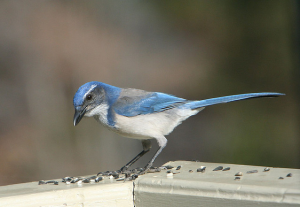
No one likes to be woken up by 6 a.m. jackhammering at the construction site next door. As it turns out, we humans have that in common with some of our wild neighbors: birds.
In an upcoming report, released online by the journal Proceedings of the Royal Society B ahead of publication, environmental scientists studied the behavior of scrub jays, common birds across the Western United States, including the San Francisco Bay Area.
The birds, they found, avoid nesting near gas wells, where constantly running compressors drowned out their communication calls. Noise had displaced the jays as surely as building a strip mall would have.
The birds’ behavioral change fits a global pattern of scientific observations, said Clinton Francis, an ecologist at the National Evolutionary Synthesis Center, in Durham, North Carolina, and the study’s lead author.
“We’re starting to see that noise may actually be a big problem,” he said, because noise acts as a form of sensory pollution, forcing animals to adapt their calls to be heard over it, or leave the area altogether. For example, bats struggle to echolocate food in noisy areas, and male frogs change the pitch of their mating calls in urban settings.
But this time, the scientists also got a surprise: When scrub jays relocate, the forest they leave behind declines.
Scrub jays are critical to the health of the piñon pine ecosystem in New Mexico, where Francis’s study site is located. The birds collect and bury pine seeds to store food for winter, but invariably forget some hiding spots. The abandoned seeds become the next generation of trees. Near the gas wells, without jays to play Johnny Appleseed, the pines are disappearing.
It didn’t take much noise to send the birds looking for quieter pastures, either. “What may not seem extremely loud to us can be disturbing to these birds,” Francis said, likening noise levels at the study site to a vacuum cleaner running in the next room, or a busy freeway a quarter-mile away.
These low-level but persistent noise levels are becoming more common as we humans expand our influence. “We forget about how noise affects health,” said Alison Ravenscraft, a Stanford University ecologist who was not affiliated with the study. “We don’t think about the fact that noise pollution might be having a huge impact on ecosystems.” Because the new study shows how effects on animal behavior can produce ecosystem-scale changes, it demonstrates these “unanticipated and sometimes drastic effects,” Ravenscraft said.
Here in California, motorists cruise 12,000 miles of freeway, travelers flit in and out of 29 commercial airports, and more than 1,000 power plants hum night and day. Silence can be hard to come by in the country’s most populous state. As evidence mounts linking noise pollution to habitat loss and, now, to ecosystem decline, researchers hope legislators will strengthen noise codes to protect wildlife.
“Noise has slipped under the radar for such a long time,” said Nathan Kleist, a University of Colorado scientist who collaborated with Francis on the scrub jay study. Scientific and conservation efforts have focused instead on more obvious forms of habitat loss, like deforestation or chemical pollution. “There’s a ton of acoustic habitat loss in the entire world, and that’s probably not going to change,” Kleist said. “But if we really do want to conserve habitat for animals, then noise levels are going to have to be a part of that.”
Awakening to bird song, in other words, means ensuring that the birds themselves aren’t woken up by jackhammers.

This is an interesting study. I live in Napa Valley, and the noise level from modified motorcycles has increased dramatically in the last few years. The bird population seems to have declined as well. We now have noise from the bikes, but much less sounds of birds singing.
Tree removal, air pollution, and high levels of pesticide use have had a big impact on what remains of nature in this area. Sound pollution in the form of the extremely loud noise of the bikes is bound to cause decline in the numbers of wildlife too.
I am perplexed that this is some sort of new study. Noise has been identified as a health hazard by the World Health Organization since 1999. The United States Federal Government passed the noise control act in 1972. Yet most states have failed to reduce noise in most average neighborhoods from leaf blowers, barking dogs, motorcycles, car and home loud stereo systems, jackhammers, roofing nailers, the list goes one and on.
So what is so amazing that what bothers people will effect birds and other animals? Local government in most areas has done very little to diminish the noise. Most noise laws with exception of human noises reference to California Penal code section 415, are allowed by poor laws that give leniency to dog owners, and non enforcement of motorcycle noise, and stereo system noise.
Oregon and Indiana should be applauded for having noise control officers who issue citations for the above mentioned noises and have reduced the noise and also put revenue in the cite coffers.
So this study just verifies what is already known since 1999, now wouldn’t it be great if someone would do something about it.